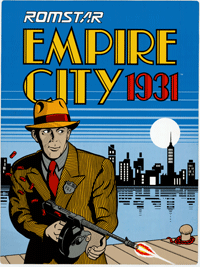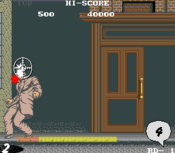Empire City: 1931
| Empire City: 1931 | |
|---|---|
 Arcade cabinet side art | |
| Developer(s) | Seibu Kaihatsu[1] |
| Publisher(s) | Seibu Kaihatsu (Arcade EU/NA) Toshiba EMI[1] (Family Computer/MSX) |
| Distributor(s) | Romstar (U.S.), Taito (Japan) |
| Producer(s) | Hitoshi Hamada |
| Platform(s) | Arcade Family Computer MSX |
| Release date(s) | Arcade:
|
| Genre(s) | Shooting gallery |
| Mode(s) | Single-player Two-player[3] |
Empire City: 1931 (エンパイア シティ:1931), also known as Street Fight, is a shooting gallery game that was originally released into arcades in 1986. The game has players taking on the mafia in 1931 New York City by gunning down mobsters one by one.
Versions of the game were released for the Family Computer (1987) and MSX (1988) as Magnum Kiki Ippatsu: Empire City: 1931 (マグナム危機一髪 エンパイアシティー1931).[4] Acclaim advertised a release for the Nintendo Entertainment System in Western regions, but the console version remained exclusive to Japan.[5]
Seibu Kaihatsu eventually released a follow-up game, Dead Angle.
Gameplay

The game is set in 1931 New York City where the player controls a young man who must avenge his family members, who were killed in a gang shootout. Over a period of several months, he targets mobsters, culminating with the mafia boss.
Players move a crosshair around the screen to aim and shoot at mobsters one at a time. They lurk around various areas, including on the street and in windows. An arrow appears that helps direct players to the location of the next mobster onscreen. Players have a set amount of time to find and shoot each enemy; if time is running out, a speech bubble appears counting down the last few seconds on the timer. When the timer reaches zero, the player is shot and the screen pans to the location of the enemy. A defend button is available as a last resort to avoid being shot.[6] Players can replenish their ammo by shooting hidden ammunition boxes and get bonus points by shooting at gold bars.
Levels are cleared after a set number of mobsters are eliminated. In the game's final level, the player has only one opportunity to assassinate the mob boss as he walks in front of windows in a building. After the final level is completed, the game loops back to the beginning.
The Famicom game is largely the same.[7] The player's progress can be restored any time in the Famicom version by using a password system of four numbers and/or letters.
Reception
A review in Computer and Video Games said the game was "fast moving, with lots of action" and called it an "unusual and addictive game" that was "bound to be a winner."[6]
References
- ↑ 1.0 1.1 Magnum Kiki Ippatsu: Empire City 1931 at MobyGames
- ↑ Magnum Kiki Ippatsu: Empire City 1931 at GameFAQs
- ↑ # of players information at Arcade Museum
- ↑ Japanese title information at SuperFamicom.org
- ↑ Cifaldi, Frank (Nov 10, 2009). "The Paper Trail: VideoGames & Computer Entertainment #1". Retronauts. 1up.com. Retrieved July 31, 2012.
- ↑ 6.0 6.1 Edgeley, Clare. "Empire City." Computer+Video Games. July 1986. p.94.
- ↑ Magnum Kiki Ippatsu: Empire City 1931 at Manna Revolver Knight